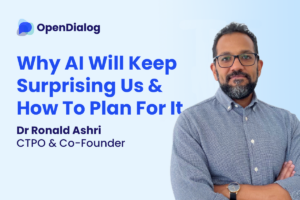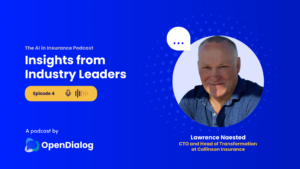Recent news of a new Conversational AI technology called ChatGPT has been all over social media and other platforms, highlighting its ability to transform the way customers interact with businesses. With this exposure, senior executives in various industries, including insurance, are looking into how they can take advantage of this groundbreaking technology.
In this article, we will specifically discuss how the insurance industry can embrace Conversational AI technologies like ChatGPT and avoid common pitfalls.
So, what is ChatGPT and Conversational AI?
ChatGPT is a large language model developed by a company called OpenAI, which is part owned by Microsoft. It has been trained using a neural network on a massive dataset of text from the internet to generate human-like responses to various prompts and questions, designed to understand natural language, analyze information, and generate coherent and contextually relevant responses to queries.
Conversational AI refers to a group of technologies that enable machines to interact with humans using natural language, therefore including ChatGPT. Conversational AI typically involves a combination of natural language processing (NLP), machine learning, and other technologies to enable machines to understand human speech and respond to it in a way that simulates a conversation with a human.
Some common examples of Conversational AI include chatbots, virtual assistants, and voice assistants like Siri or Alexa.
Using the power of Conversational AI, insurers can now create highly sophisticated voice and digital assistants that automate a broad range of activities from policy quotation and sales, through to managing claims and mid-term adjustments, with sophistication and accuracy level to enable the automation of over 80% of all customer interactions without the need for human intervention.
What are the key benefits to insurers seeking to adopt Conversational AI?
Increased operational efficiency:
Conversational AI powered voice and digital assistants can help automate routine tasks and processes, such as claims processing and policy inquiries. This can help reduce operational costs for insurers while improving efficiency.
Increased sales and revenue:
These voice and digital assistants can help insurers cross-sell and upsell additional insurance products and services to customers. By providing hyper-personalized recommendations and tailored policy options, insurers can increase sales and revenue.
Improved data and customer insights:
Artificial Intelligence can help insurers collect and analyze data more effectively. By automating data collection and analysis, insurers can reduce errors and improve data accuracy, which can help inform business decisions, improve competitiveness and improve customer service.
Easily provide multilingual customer support around the clock:
Conversational AI powered voice and digital assistants enable insurers to quickly and easily provide round-the-clock support to customers, regardless of their location or time zone and in many languages. This can help insurers provide better customer service and support, particularly for customers in different regions of the world.
According to KPMG, 68% of insurance CEOs say they will focus on customer-centric technologies such as chatbots [1].
What are the pitfalls associated with implementing ChatGPT in an insurance business?
There are many risks associated with the adoption of ChatGPT and other large language models. Insurers should determine the exposure of all risks and address appropriately, however a few of most significant things to be aware of include:
Incorrect Information or “Hallucinations”
These hallucinations lead to the technology providing false answers. This is because the system uses ‘statistics’ to pick the next word and in reality has no actual ‘understanding’ of content.
Lack of explainability
It is not possible to identify the source of information and answers to the same underlying query invariably change depending on phrasing or “prompt”, not ideal in a highly regulated industry where accuracy and audibility are non-negotiable.
Training data issues
There can be serious repercussions if the system is trained with data that is obsolete, biased, prohibited or data that is incorrect. Insurers should consider if they have the skills, governance processes and appetite to train highly technical language models.
Intellectual property (IP) and copyright infringements
It is important to ensure that any information surfaced through a Conversational AI assistant does not breach IP and copyright laws when serving information. Again, considerations in training data sources and tight governance are key here.
Creation of technical debt
ChatGPT is the first Large Language Model to garner mainstream notoriety, however it is not the only game in town and the pace of change means we will see exponential growth in the capabilities of these technologies in coming years and can expect further developments from many industry giants – Google Bard anyone?
Insurers need to ensure they avoid locking themselves into a technology that could quickly become outdated.
So how do insurers take advantage of Conversational AI and avoid these serious pitfalls?
There are a number of steps that insurers can take that will enable them to quickly and easily take advantage of Conversational AI today.
Regardless of technology selection, it is imperative that insurers develop processes and policies that identify potential issues and can highlight them should they occur. Having effective governance in place and ensuring these policies are adhered to are enforced is critical, as an example, ensuring it is understood where explainability is required and in those specific scenarios, ensuring a clear and explainable approach.
To help simplify and accelerate the adoption of Conversational AI in a safe and effective manner, there are now a number of Conversational AI platforms available in the market today that allow companies to create and deploy chatbots, virtual assistants, and other conversational interfaces that can interact with users using natural language.
Created by a team of renowned leaders in the global Conversational AI field, OpenDialog AI Ltd has developed such a Conversational AI platform that enables quick and easy creation of highly sophisticated and powerful Conversational AI voice and digital assistants, enabling insurers to provide an automated, hyper-personalized, data-driven, and multi-channel digital insurance experience. The solution is designed to be multilingual and available 24/7, ensuring customers can easily communicate with their insurance providers at their convenience.
Conclusion
Conversational AI has the potential to revolutionize the insurance industry, offering benefits such as increased operational efficiency, improved data and customer insights, and the ability to provide multilingual customer support around the clock. However, there are also significant risks associated with the adoption of this technology, including incorrect information, lack of explainability, and training data issues.
To successfully implement Conversational AI, insurers will need to invest in developing the technical and business skills required and ensure that effective governance processes and policies are in place to manage the risks associated with the technology.
With the right approach, Conversational AI has the potential to drive significant value for insurers and their customers, enabling a more personalized and efficient service while reducing costs and improving profitability.
By leveraging a Conversational AI platform such as OpenDialog, insurers can safely accelerate their Conversational AI journey, creating highly sophisticated voice and digital assistants in only a few weeks.
OpenDialog is helping insurers around the world, meet the evolving needs and expectations of insurance customers in an increasingly digital world, supporting industry leading operating expense ratios and the highest levels of customer satisfaction.

This article was written by Dean Chapman, Chief Commercial Officer of OpenDialog AI Ltd



